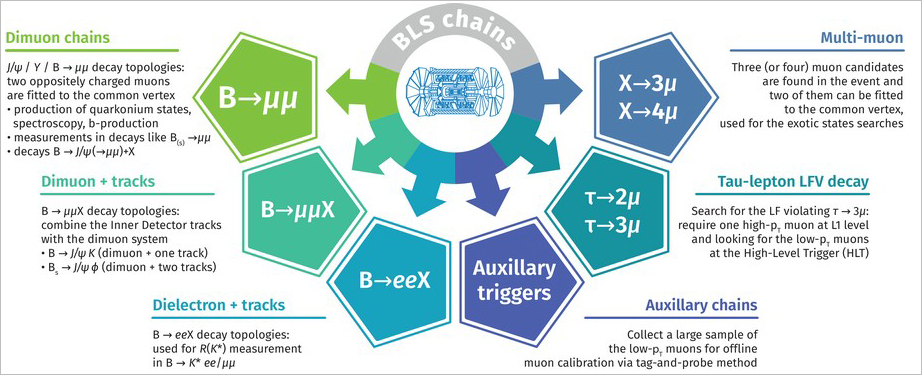Development of a Software Trigger for the Detector of the ATLAS Experiment
News, 12 August 2021
On 22 June 2021, at the regular 55th session of the JINR Programme Advisory Committee on particle physics, a report of the group of scientists from the Dzhelepov Laboratory of Nuclear Problems involved in development of a software trigger for the detector of the ATLAS experiment was given. The DLNP Group of Scientific Communication talked to the trigger group coordinator Vladimir Lyubushkin, Candidate of Physics and Mathematics, a senior researcher of the Laboratory, about this facility and current results.
 The ATLAS detector is one of four main detectors of the Large Hadron Collider (LHC). In 2021, the ATLAS and CMS collaborations announced the discovery of the Higgs boson, the last elementary particle of the Standard Model. Experimental data obtained at the multipurpose ATLAS detector are used for further studies of the Higgs boson properties and also for the search for effects that cannot be described within the Standard Model (so-called New Physics). The DLNP scientists are actively taking part in the ATLAS collaboration.
The ATLAS detector is one of four main detectors of the Large Hadron Collider (LHC). In 2021, the ATLAS and CMS collaborations announced the discovery of the Higgs boson, the last elementary particle of the Standard Model. Experimental data obtained at the multipurpose ATLAS detector are used for further studies of the Higgs boson properties and also for the search for effects that cannot be described within the Standard Model (so-called New Physics). The DLNP scientists are actively taking part in the ATLAS collaboration.
At present, two groups from our Laboratory are involved in the detector upgrade: a group dealing with development, design and testing of track systems based on Micromegas drift chambers for the muon spectrometer (headed by Aleksi Gongadze, watch his recent seminar “Development and Design of Large-Area Tracking Systems for the Muon Spectrometer of the ATLAS Experiment at the Large Hadron Collider”), and a group on the development of a software trigger for detection of decays of hadrons containing heavy b- and c-quarks (coordinated by Vladimir Lyubushkin).
The activities of both groups are related to the next, second, upgrade of the LHC which is about to be completed soon. Already in 2022, the third stage (Run 3) of data taking will be launched. The upgrade will change beam energy and beam parameters, and also the detector configuration. While the hardware is being changed, the facility software must be changed as well.
It is what Vladimir Lyubushkin and his researchers are dealing with. The DLNP group is “built into” in the ATLAS data collection team. Its objective is to develop a software trigger for selecting B physics data of the ATLAS experiment. The number of events detected by the facility is tremendous. The major part of them is of little or no value at all for the scientists, and there is no sense in storing these data. Primary low-level selection is performed by electronics, the so-called “hardware trigger”. The selected data are recorded into a buffer. The amount of these data (raw data) still remains so immense that not disks but terabyte tapes are used to record them.
Then, the data go through the second selection, this time via software. Software algorithms of partial reconstruction are activated at this stage. They permit making quick decisions whether detected events are of value to the scientists. The algorithms reduce the number of the selected events from 100 000 to 1,500 events per second. The objective of the group coordinated by Vladimir Lyubushkin is to develop a trigger able to select the rarest and the most relevant events and to record data for further analyses.
 Categories of B physics events selected via the ATLAS software trigger. The diagram authored by V. Lyubushkin (DLNP)
Categories of B physics events selected via the ATLAS software trigger. The diagram authored by V. Lyubushkin (DLNP)
The current objective of the group is to complete design and testing of the new trigger by the end of the year. The work proceeds as scheduled. On 19 July 2021, the expanded meeting of the trigger group coordinators was held at CERN where the high level of readiness for data taking was appreciated (above 80% of scheduled activities are completed).
Wrapping up our conversation with Vladimir Viktorovich, we ask him whether there is more physics or programming in his work. “I guess programming after all. However, programming is just a tool. I’m a physicist, and my goal is to take data of high quality. And the way we do this is not so important. One can use even a calculator. However, to develop computer software seems to be much more helpful.”
We wish the ATLAS data analysis group at DLNP to complete the set tasks successfully and on schedule!
Source: DLNP